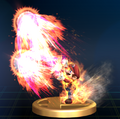Mario (SSBB)
| Mario in Super Smash Bros. Brawl | |
|---|---|
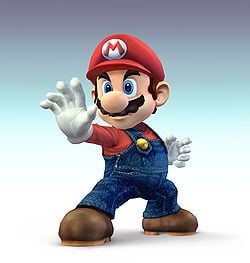 
| |
| Universe | Mario |
| Other playable appearances | in SSB in Melee in SSB4 in Ultimate |
| Availability | Starter |
| Final Smash | Mario Finale |
| Tier | F (31) |
Mario (マリオ, Mario) is a playable character in Super Smash Bros. Brawl, who also appears in Super Smash Bros. Melee and the original Super Smash Bros. He is the icon of Nintendo and the Mario series. Charles Martinet reprises his role as Mario, now providing new voice clips, sounding more akin to his appearances from Super Mario Galaxy onwards.
Mario is ranked 31st out of 38 on the current tier list, the top position of F tier. This is a vast drop from his previous placement in Melee, where he was ranked 15th out of 26, and his worst placement in the series to date. Mario possesses fast, low lag attacks throughout his moveset, as well as strong comboing capabilities, with his up tilt and up aerial being especially good jugglers on their own that can set up additional attacks well. Additionally, Mario possesses a notable gimping and disrupting tool in his Cape, an effective projectile in his Fireball, and even an effective out of shield option in his Super Jump Punch. However, his inherited problems from his Melee incarnation have been further exacerbated. Mainly, he has poor reach with nearly every attack, giving him problems dealing with characters who have disjointed hitboxes (such as Marth) and is easily gimped due to his predictable and short recovery. Mario also still possesses poor KO potential: He only has a few mediocre finishers (all being smash attacks), while his back aerial has below average power, only KOing at very high percents, and his forward aerial, despite being a meteor smash, is slow and too weak for KOing unless sweetspotted. As a result, he has no other effective finishers outside of his forward and up smashes, which combined with the existence of stale-move negation, makes it difficult for him to score a KO, forcing him to not overrely on his forward and up smashes and keeping them fresh to take the stock. Lastly, his rather standard abilities are outshined by the abilities of most characters. This has resulted in poor matchups beyond low tier, and terrible tournament results. However, on the Japanese tier list, Mario is ranked 25th out of 36 in the top of D tier, where he is considered to be a mid tier character rather than a low tier.
Attributes
Mario is a relatively straightforward, balanced character, with average attributes and a variety of tools designed to tackle any situation. His weight, dashing speed, air speed, and traction all range from average to slightly above average, though his falling speed and gravity both fall within the lower half of the cast.
Mario also has rather good aerials, as they are fairly quick and have decent power. His neutral aerial is a very quick sex kick, up aerial is his main juggling tool and is very useful in combos, forward aerial is a meteor smash that is somewhat useful for edgeguarding, back aerial is a fast and useful KO tool offstage, and down aerial is fast, deals solid damage, and can lead to combos.
His specials are useful too. Fireball is a projectile that is able to interrupt approaches and can somewhat remedy Mario's short range. Cape is a reflector that can also be used to gimp opponents, and can be used as a option for recovery as it boosts Mario upwards slightly. Super Jump Punch is Mario's main recovery move and Mario's fastest out of shield option. As it deals a reasonable amount of damage, it can also be used as a combo finisher. Lastly, F.L.U.D.D does no damage, but it can be charged to unleash a powerful windbox that can be used to push opponents away, leading to edgeguards or simply blowing them offstage.
Despite his strengths, he has many glaring flaws. Compared to Melee, his already poor KO potential has been further worsened. His forward and up smashes are relatively weak compared to the rest of the cast, his back aerial has short range, back throw is easy to DI due to its slow startup, and forward aerial is slow, laggy, and can be meteor cancelled. However, Mario's most glaring flaw is his poor reach. While Mario does have a projectile, the rest of his attacks are very short ranged, forcing him to get up close to do meaningful damage or land KOs. Coupled with Mario's average speed, he can have difficulty landing hits on enemies who outrange him, such as Marth and Meta Knight. His recovery is also rather mediocre. While Super Jump Punch is fast, it follows a predictable path and doesn't go particularly far, leading to Mario getting gimped rather easily. His grab game, while decent, is rendered less effective by his short grab and hitstun canceling limiting his combo potential.
Overall, Mario's weaknesses overshadow his strengths, resulting in poor matchups and tournament representation.
Changes from Super Smash Bros. Melee
Mario has received a mix of nerfs and buffs from Melee to Brawl, but his buffs are flooded over by his more pronounced flaws from his previous incarnation, and the changes to Brawl's mechanics hinder Mario more than they help him. As a result, he was heavily nerfed overall. The removal of wavedashing hinders Mario's mobility and grounded approach, while the introduction of hitstun canceling limits Mario's combo game, and his up and down throws cannot chaingrab anymore because of that. His already mediocre KO power was reduced even further, almost completely removing his back throw's KO potential and his back aerial is still weak for its type, KOing opponents onstage only at very high percentages, forcing him to overuse his forward and up smashes to secure a KO, with the former being slower, and his smash attacks in general are less useful overall, with forward smash's sweetspot being weaker and is now outprioritized by a stronger sourspot while up smash and the front hit of down smash also deal less damage and knockback.
Overall, Mario is consider less effective than he was in SSB64 and Melee. He is one of the characters to have been the most severely nerfed in his transition from Melee.
Aesthetics
 Mario has been updated graphically, with his overalls looking more realistic. Additionally, the color of his cap, shirt, and overalls are a darker shade of red and blue and his skin became paler.
Mario has been updated graphically, with his overalls looking more realistic. Additionally, the color of his cap, shirt, and overalls are a darker shade of red and blue and his skin became paler. Mario no longer speaks during his first jump, and all of his jumps make variations of the "boing" noise from Super Mario Bros.; the pitch increases with each jump: the short ground and wall jumps make a shortened version, the high ground jump uses the unaltered standard version, and the second jump and Super Jump Punch each make higher-pitched versions.
Mario no longer speaks during his first jump, and all of his jumps make variations of the "boing" noise from Super Mario Bros.; the pitch increases with each jump: the short ground and wall jumps make a shortened version, the high ground jump uses the unaltered standard version, and the second jump and Super Jump Punch each make higher-pitched versions. Mario shouts at both the start and end instead of saying "Here we go!" at end during his left- and right-inputted victory poses; he also now vocalizes during his up-inputted victory pose.
Mario shouts at both the start and end instead of saying "Here we go!" at end during his left- and right-inputted victory poses; he also now vocalizes during his up-inputted victory pose. Mario no longer uses his stun voice clip when waking out of sleep status.
Mario no longer uses his stun voice clip when waking out of sleep status. Mario has a new alternate costume based on Fire Mario.
Mario has a new alternate costume based on Fire Mario. Mario now has two new taunts: a side taunt where he spins, removes his hat and puts him back on his head, resembling the level clear animation from New Super Mario Bros., and a down taunt where he spins around in the air, falls to the ground and the gets up, similarly to his dying animation in Donkey Kong.
Mario now has two new taunts: a side taunt where he spins, removes his hat and puts him back on his head, resembling the level clear animation from New Super Mario Bros., and a down taunt where he spins around in the air, falls to the ground and the gets up, similarly to his dying animation in Donkey Kong.
Attributes
 Mario's character model is slightly smaller, more in line with his own games, making him harder to hit but decreasing his reach.
Mario's character model is slightly smaller, more in line with his own games, making him harder to hit but decreasing his reach. Mario is slightly lighter (100 → 98).
Mario is slightly lighter (100 → 98). As with the returning veterans, Mario's falling speed was reduced (1.7 → 1.28). Compared with the returning veterans, however, Mario falls faster. While improving his vertical endurance, it makes him more vulnerable to combos and worsens his already poor recovery.
As with the returning veterans, Mario's falling speed was reduced (1.7 → 1.28). Compared with the returning veterans, however, Mario falls faster. While improving his vertical endurance, it makes him more vulnerable to combos and worsens his already poor recovery. Mario's gravity is lower (0.095 → 0.075).
Mario's gravity is lower (0.095 → 0.075). Mario jumps significantly higher (26.70398026 → 31.755375), going from the 4th lowest out of 26 characters to the 25th highest out of 39.
Mario jumps significantly higher (26.70398026 → 31.755375), going from the 4th lowest out of 26 characters to the 25th highest out of 39. Mario's traction has been unchanged (0.06). Compared with the returning veterans, however, Mario's traction is significantly higher, making it easier for him to punish out of shield.
Mario's traction has been unchanged (0.06). Compared with the returning veterans, however, Mario's traction is significantly higher, making it easier for him to punish out of shield. Mario's air speed is higher (0.86 → 0.94), improving his recovery and aerial approach.
Mario's air speed is higher (0.86 → 0.94), improving his recovery and aerial approach. Mario's additional air acceleration is higher (0.025 → 0.08), increasing the total amount (0.045 → 0.09) despite his base air acceleration being lower (0.02 → 0.01). His air acceleration has gone from being the 5th lowest out of 26 characters in Melee to the 13th highest out of 39 characters in Brawl.
Mario's additional air acceleration is higher (0.025 → 0.08), increasing the total amount (0.045 → 0.09) despite his base air acceleration being lower (0.02 → 0.01). His air acceleration has gone from being the 5th lowest out of 26 characters in Melee to the 13th highest out of 39 characters in Brawl. Mario's sidestep has a longer duration (frames 2-15 → 2-20).
Mario's sidestep has a longer duration (frames 2-15 → 2-20). Sidestep has more ending lag (FAF 23 → 26).
Sidestep has more ending lag (FAF 23 → 26). Rolls have more ending lag (FAF 32 → 33).
Rolls have more ending lag (FAF 32 → 33). The removal of wavedashing hinders Mario's mobility and grounded approach.
The removal of wavedashing hinders Mario's mobility and grounded approach.
Ground attacks
- Neutral attack
 Holding down the attack button now makes Mario quickly repeat the first hit of neutral attack until it connects, improving its punish potential.
Holding down the attack button now makes Mario quickly repeat the first hit of neutral attack until it connects, improving its punish potential. The second hit has less startup lag (frame 3 → 2).
The second hit has less startup lag (frame 3 → 2). Both the first and second hits have different angles (83°/85° → 361°/80°). This allows the near hits to jab lock opponents.
Both the first and second hits have different angles (83°/85° → 361°/80°). This allows the near hits to jab lock opponents.
 However, this makes the far hits connect into the later hits less reliably.
However, this makes the far hits connect into the later hits less reliably.
 The last hit deals less damage (5% → 4%) without full compensation on its knockback (10 (base)/100 (scaling) → 30/95).
The last hit deals less damage (5% → 4%) without full compensation on its knockback (10 (base)/100 (scaling) → 30/95). The last hit has more startup with a shorter duration (frames 5-9 → 7-10), more ending lag (FAF 23 → 30).
The last hit has more startup with a shorter duration (frames 5-9 → 7-10), more ending lag (FAF 23 → 30).
- Forward tilt
 Forward tilt deals more base knockback (6 → 8), and no longer deals minimal set knockback (1 → 0) when angled down.
Forward tilt deals more base knockback (6 → 8), and no longer deals minimal set knockback (1 → 0) when angled down. It has less ending lag (FAF 33 → 25).
It has less ending lag (FAF 33 → 25). It now deals consistent damage across all angles (10% (up)/9% (non-angled)/8% (down) → 8%), weakening both the up and non-angled versions.
It now deals consistent damage across all angles (10% (up)/9% (non-angled)/8% (down) → 8%), weakening both the up and non-angled versions.
- Up tilt
 Up tilt deals less damage (8% → 7%) without full compensation on its knockback (26 (base)/125/122/120 (scaling) → 28/130).
Up tilt deals less damage (8% → 7%) without full compensation on its knockback (26 (base)/125/122/120 (scaling) → 28/130).
 However, this allows it to chain into itself more reliably at lower percents.
However, this allows it to chain into itself more reliably at lower percents.
 It has more startup with a shorter duration (frames 4-12 → 5-11).
It has more startup with a shorter duration (frames 4-12 → 5-11). The introduction of hitstun canceling removes all its combo ability except into itself at low percents.
The introduction of hitstun canceling removes all its combo ability except into itself at low percents.
- Down tilt
 Down tilt deals less damage (8%/9% → 5%/7%), with only a slight increased to its base knockback (10 → 20).
Down tilt deals less damage (8%/9% → 5%/7%), with only a slight increased to its base knockback (10 → 20). Its has a shorter duration (frames 5-8 → 5-7).
Its has a shorter duration (frames 5-8 → 5-7).
- Dash attack
 Dash attack no longer has consistent angles (110° → 110°/80° (clean), 120° → 120°/70° (late)).
Dash attack no longer has consistent angles (110° → 110°/80° (clean), 120° → 120°/70° (late)).
- Forward smash
 Forward smash's animation has been slightly changed. Mario rears back more while standing on one leg during the charging animation, while stepping and leaning forward upon unleashing the move and having his right arm positioned lower.
Forward smash's animation has been slightly changed. Mario rears back more while standing on one leg during the charging animation, while stepping and leaning forward upon unleashing the move and having his right arm positioned lower. Forward smash's sourspot deals consistent damage when not angled (11%/10% → 14%), improving its KO potential.
Forward smash's sourspot deals consistent damage when not angled (11%/10% → 14%), improving its KO potential. Its sourspot has more knockback scaling (96 → 100).
Its sourspot has more knockback scaling (96 → 100). It has more startup with a shorter duration (frames 12-16 → 16-18) and more ending lag (FAF 42 → 48).
It has more startup with a shorter duration (frames 12-16 → 16-18) and more ending lag (FAF 42 → 48). Its sweetspot deals less damage across all angles (19% (up)/18% (non-angled)/17% (down) → 18%/17%/16%).
Its sweetspot deals less damage across all angles (19% (up)/18% (non-angled)/17% (down) → 18%/17%/16%). Its sweetspot has less knockback scaling (95 → 90).
Its sweetspot has less knockback scaling (95 → 90). The sweetspot is now placed at the bottom of the ID stack (0 → 2), making it significantly harder to connect with, especially on larger characters.
The sweetspot is now placed at the bottom of the ID stack (0 → 2), making it significantly harder to connect with, especially on larger characters.
- Up smash
 Up smash's animation has been altered, being a mixture of its animations in the original Super Smash Bros. and in Super Smash Bros. Melee: during the headbutt, Mario performs a small jump and does a step forward.
Up smash's animation has been altered, being a mixture of its animations in the original Super Smash Bros. and in Super Smash Bros. Melee: during the headbutt, Mario performs a small jump and does a step forward. The new animation improves its vertical range.
The new animation improves its vertical range. The introduction of DACUS improves its approach potential.
The introduction of DACUS improves its approach potential. Up smash has a longer duration (frames 9-11 → 9-14), improving its horizontal range in front of Mario when combined with the new animation.
Up smash has a longer duration (frames 9-11 → 9-14), improving its horizontal range in front of Mario when combined with the new animation. It deals less damage (15% → 14%) and has decreased knockback scaling (97 → 90), hindering its KO potential.
It deals less damage (15% → 14%) and has decreased knockback scaling (97 → 90), hindering its KO potential.
- Down smash
 Down smash's back hit no longer has a sourspot (10%/12% → 12%), allowing it to KO more consistently.
Down smash's back hit no longer has a sourspot (10%/12% → 12%), allowing it to KO more consistently. Its front hit deals less damage (16% → 15%).
Its front hit deals less damage (16% → 15%). Its front hit has less knockback scaling (75 → 73), hindering its KO potential.
Its front hit has less knockback scaling (75 → 73), hindering its KO potential.
Aerial attacks
 All aerials except forward aerial have decreased landing lag (16/8 frames → 10 (neutral), 15/7 frames → 10 (back), 15/7 frames → 10 (up), 23/11 frames → 19 (down)). Due to the removal of L-canceling, however, their landing lag is not fully compensated.
All aerials except forward aerial have decreased landing lag (16/8 frames → 10 (neutral), 15/7 frames → 10 (back), 15/7 frames → 10 (up), 23/11 frames → 19 (down)). Due to the removal of L-canceling, however, their landing lag is not fully compensated.
 Back and up aerials can now be performed twice in a short hop due to Mario's higher short hop.
Back and up aerials can now be performed twice in a short hop due to Mario's higher short hop.
- Neutral aerial
 Neutral aerial auto-cancels slightly earlier (frame 36 → 34) and can now auto-cancel in a short hop due to Mario's higher short hop.
Neutral aerial auto-cancels slightly earlier (frame 36 → 34) and can now auto-cancel in a short hop due to Mario's higher short hop. Its deals less damage (12% (clean)/6% (late) → 10%/5%), hindering its KO potential.
Its deals less damage (12% (clean)/6% (late) → 10%/5%), hindering its KO potential. It has a shorter duration (frames 3-32 → 3-29).
It has a shorter duration (frames 3-32 → 3-29). The late hit deals less knockback (15 (base)/100 (scaling) → 13/90). However, this enables it to lock opponents for longer.
The late hit deals less knockback (15 (base)/100 (scaling) → 13/90). However, this enables it to lock opponents for longer.
- Forward aerial
 Forward aerial has less startup lag with a longer duration (frames 18-22 → 16 (early)/17-19 (clean)/20-21 (late)).
Forward aerial has less startup lag with a longer duration (frames 18-22 → 16 (early)/17-19 (clean)/20-21 (late)). It now consists of an early hit, a clean hit and a late hit; with the early and late hits launching opponents horizontally (280° → 361°).
It now consists of an early hit, a clean hit and a late hit; with the early and late hits launching opponents horizontally (280° → 361°).
 This makes the early hit more effective at KOing opponents on stage.
This makes the early hit more effective at KOing opponents on stage. However, this makes the move less consistent at edgeguarding overall as the clean hit has a much shorter duration (frames 18-22 → 17-19).
However, this makes the move less consistent at edgeguarding overall as the clean hit has a much shorter duration (frames 18-22 → 17-19).
 Mario's lower falling speed makes the move safer to use off stage.
Mario's lower falling speed makes the move safer to use off stage. It deals less damage (15% → 12% (early)/13% (clean)/10% (late)), without full compensation on its knockback (30 (base)/70 (scaling) → 30/80 (early), 20/75 (clean), 20/80 (late)).
It deals less damage (15% → 12% (early)/13% (clean)/10% (late)), without full compensation on its knockback (30 (base)/70 (scaling) → 30/80 (early), 20/75 (clean), 20/80 (late)).
 However the changes to meteor canceling makes it more reliable at edeguarding despite its decreased power.
However the changes to meteor canceling makes it more reliable at edeguarding despite its decreased power.
 It has increased landing lag (21 → 26 frames).
It has increased landing lag (21 → 26 frames).
- Back aerial
 Back aerial has an altered animation based on Mario's forward aerial from Smash 64, albeit without spinning.
Back aerial has an altered animation based on Mario's forward aerial from Smash 64, albeit without spinning.
 This new animation gives the move more range.
This new animation gives the move more range. However, this new animation is longer (28 frames → 45), increasing the amount of time Mario cannot grab the ledge after using the move.
However, this new animation is longer (28 frames → 45), increasing the amount of time Mario cannot grab the ledge after using the move.
 Its clean hit deals more damage (11% → 12%) without full compensation on its knockback scaling (100 → 95).
Its clean hit deals more damage (11% → 12%) without full compensation on its knockback scaling (100 → 95). Its late hit deals less damage (9% → 7%) and has decreased knockback scaling (100 → 90).
Its late hit deals less damage (9% → 7%) and has decreased knockback scaling (100 → 90).
 Its reduced knockback enables the late hit to lock opponents for longer.
Its reduced knockback enables the late hit to lock opponents for longer.
 It has a shorter hitbox duration (frames 6-17 → 6-13).
It has a shorter hitbox duration (frames 6-17 → 6-13). It has more ending lag (FAF 29 → 34).
It has more ending lag (FAF 29 → 34).
- Up aerial
 Up aerial has increased base knockback (0 → 9) and launches at a lower angle (55° → 45°), improving its safety, edgeguarding and KO potential.
Up aerial has increased base knockback (0 → 9) and launches at a lower angle (55° → 45°), improving its safety, edgeguarding and KO potential. Its lower angle hinders its juggling potential which is further exacerbated with the introduction of hitstun cancelling; removing its combo potential beyond low percents.
Its lower angle hinders its juggling potential which is further exacerbated with the introduction of hitstun cancelling; removing its combo potential beyond low percents.
- Down aerial
 Mario has a new down aerial: Mario Tornado, which was previously his down special. As a result, its hitbox timings have been altered (frames 10-11, 13-14, 16-17, 19-20, 22-23, 25-26, 28-29 → 5, 7, 9, 11, 13, 25).
Mario has a new down aerial: Mario Tornado, which was previously his down special. As a result, its hitbox timings have been altered (frames 10-11, 13-14, 16-17, 19-20, 22-23, 25-26, 28-29 → 5, 7, 9, 11, 13, 25).
 Because of this, the move has more ending lag overall.
Because of this, the move has more ending lag overall.
 It has much less startup lag (frame 10 → 5).
It has much less startup lag (frame 10 → 5).
 However, each hit has a shorter duration (2 frames → 1).
However, each hit has a shorter duration (2 frames → 1).
 The loop hits have reduced set knockback (30 → 10) and there is a shorter gap between each hit (2 frames → 1), making them connect more reliably.
The loop hits have reduced set knockback (30 → 10) and there is a shorter gap between each hit (2 frames → 1), making them connect more reliably. The last hit deals more damage (2% → 7%) and knockback (30 (set)/100 (scaling) → 80 (base)/80 (scaling)), granting it KO and juggling potential.
The last hit deals more damage (2% → 7%) and knockback (30 (set)/100 (scaling) → 80 (base)/80 (scaling)), granting it KO and juggling potential. It can now auto-cancel in a short hop due to Mario's higher short hop.
It can now auto-cancel in a short hop due to Mario's higher short hop. The last hit's angle has been altered (94° → 75°).
The last hit's angle has been altered (94° → 75°). The loop hits deal less damage (2% → 1%).
The loop hits deal less damage (2% → 1%). Due to hitting six times instead of seven coupled with the loop hits dealing less damage, the move's maximum damage potential is lower (14.74% → 12%).
Due to hitting six times instead of seven coupled with the loop hits dealing less damage, the move's maximum damage potential is lower (14.74% → 12%). There is now a large gap between the last two hits (2 frames → 11) which allows the opponent to either trade with down aerial if they have a frame 3 aerial or they can avoid it (and potentially punish Mario) if they have a fast, intangible special move.
There is now a large gap between the last two hits (2 frames → 11) which allows the opponent to either trade with down aerial if they have a frame 3 aerial or they can avoid it (and potentially punish Mario) if they have a fast, intangible special move. Down aerial's new animation is longer (38 frames → 44), increasing the amount of time Mario cannot grab the ledge after using the move.
Down aerial's new animation is longer (38 frames → 44), increasing the amount of time Mario cannot grab the ledge after using the move. With the addition of SDI multipliers in Brawl, the loop hits have received above-average multipliers (1× → 1.5×), allowing opponents to escape them more easily.
With the addition of SDI multipliers in Brawl, the loop hits have received above-average multipliers (1× → 1.5×), allowing opponents to escape them more easily.
Throws/other attacks
- Grabs:
 Standing grab has less startup lag (frame 7 → 6) and both his standing and dash grabs have less ending lag (FAF 31 → 30 (standing), frame 41 → 40 (dash).
Standing grab has less startup lag (frame 7 → 6) and both his standing and dash grabs have less ending lag (FAF 31 → 30 (standing), frame 41 → 40 (dash). Dash grab has more startup lag (frame 11 → 12).
Dash grab has more startup lag (frame 11 → 12).
- Pummel:
 Pummel has less ending lag (FAF 25 → 24).
Pummel has less ending lag (FAF 25 → 24).
- Forward throw:
 Forward throw can now chain grab at low percents, due to DI being changed in Brawl to have no effect if a move doesn't cause tumbling.
Forward throw can now chain grab at low percents, due to DI being changed in Brawl to have no effect if a move doesn't cause tumbling.
- Back throw:
 Back throw deals less knockback (80 (base)/65 (scaling) → 70/63), hindering its KO potential.
Back throw deals less knockback (80 (base)/65 (scaling) → 70/63), hindering its KO potential.
- Up throw:
 Up throw can no longer combo or chaingrab due to the hitstun changes.
Up throw can no longer combo or chaingrab due to the hitstun changes.
- Down throw:
 Down throw can no longer combo or chaingrab due to the hitstun changes, and has increased knockback scaling (30 → 50), severely reducing its utility.
Down throw can no longer combo or chaingrab due to the hitstun changes, and has increased knockback scaling (30 → 50), severely reducing its utility.
- Floor attack:
 Front floor attack no longer has a hitbox with set knockback.
Front floor attack no longer has a hitbox with set knockback.
- Edge attack:
 Both edge attacks have increased set knockback (90 → 110).
Both edge attacks have increased set knockback (90 → 110).
Special moves
- Fireball:
 Fireball can now be B-reversed.
Fireball can now be B-reversed. Mario can now auto cancel Fireballs in a short hop due to his lower falling speed.
Mario can now auto cancel Fireballs in a short hop due to his lower falling speed. It deals slightly more knockback and a larger hitbox.
It deals slightly more knockback and a larger hitbox. Fireballs deals slightly less damage (6% → 5%).
Fireballs deals slightly less damage (6% → 5%). Fireballs travels a shorter distance.
Fireballs travels a shorter distance. Fireballs look more realistic and have a revamped sound effect.
Fireballs look more realistic and have a revamped sound effect.
- Cape:
 Cape can now be B-reversed.
Cape can now be B-reversed. It now reverses the opponent's momentum rather than just reversing their direction, and temporarily reverses their controls as well, making it much more effective as a disrupting tool. Mario also now has access to several new techniques such as the Cape Glide, greatly improving its utility.
It now reverses the opponent's momentum rather than just reversing their direction, and temporarily reverses their controls as well, making it much more effective as a disrupting tool. Mario also now has access to several new techniques such as the Cape Glide, greatly improving its utility. It deals less damage when performed on the ground (10%/8% (ground)/8%/6% (air) → 8/6%).
It deals less damage when performed on the ground (10%/8% (ground)/8%/6% (air) → 8/6%). It has less range.
It has less range. Its effectiveness as an edgeguarding tool have been reduced due to characters being able to grab the ledge from behind in Brawl.
Its effectiveness as an edgeguarding tool have been reduced due to characters being able to grab the ledge from behind in Brawl. If Mario hits certain characters out of their specials moves with Cape (including Sonic's Spring Jump, Mr. Game & Watch's Fire, Snake's Cypher or Diddy Kong's Monkey Flip), they will be able to reuse their specials making Cape a non-viable edgeguarding option against those characters.
If Mario hits certain characters out of their specials moves with Cape (including Sonic's Spring Jump, Mr. Game & Watch's Fire, Snake's Cypher or Diddy Kong's Monkey Flip), they will be able to reuse their specials making Cape a non-viable edgeguarding option against those characters. It no longer deals vertical knockback on opponents attempting a grab.
It no longer deals vertical knockback on opponents attempting a grab. Mario no longer vocalizes when using Cape. Additionally, Cape has a different sound effect.
Mario no longer vocalizes when using Cape. Additionally, Cape has a different sound effect. Removed the Cape Teleportation glitch that resulted opponents warping to the opposite side of the stage after being hit during the ledge get up.
Removed the Cape Teleportation glitch that resulted opponents warping to the opposite side of the stage after being hit during the ledge get up.
- Super Jump Punch:
 Super Jump Punch has received several changes to allow it to connect more reliably: the first hit's outermost hitbox has more set knockback (120 → 130), the second to fourth hits have consistent set knockback (110/150 → 150) and a higher angle on their outermost hitbox (78° → 90°), and the fifth and sixth hits use the autolink angle (72°/78° → 365°), in addition to all hits benefiting from the DI changes in Brawl.
Super Jump Punch has received several changes to allow it to connect more reliably: the first hit's outermost hitbox has more set knockback (120 → 130), the second to fourth hits have consistent set knockback (110/150 → 150) and a higher angle on their outermost hitbox (78° → 90°), and the fifth and sixth hits use the autolink angle (72°/78° → 365°), in addition to all hits benefiting from the DI changes in Brawl. Its last hit deals more knockback (40 (base)/140 (scaling) → 52/145) and launches at a higher angle (50° → 60°), allowing it to KO near the upper blast line much more effectively.
Its last hit deals more knockback (40 (base)/140 (scaling) → 52/145) and launches at a higher angle (50° → 60°), allowing it to KO near the upper blast line much more effectively. It now deals seven hits instead of nine, with its hitbox timings altered (frames 3-24 → 3-15), shortening its duration and reducing its total damage output (14.1% → 12%).
It now deals seven hits instead of nine, with its hitbox timings altered (frames 3-24 → 3-15), shortening its duration and reducing its total damage output (14.1% → 12%). It can no longer cancel itself into a wall jump.
It can no longer cancel itself into a wall jump. Super Jump Punch has an altered landing animation where Mario lands on his back as opposed to his feet.
Super Jump Punch has an altered landing animation where Mario lands on his back as opposed to his feet.
- F.L.U.D.D.:
 Mario has a new down special: F.L.U.D.D., replacing Mario Tornado from Melee. It is a chargeable move that fires water that pushes opponents away.
Mario has a new down special: F.L.U.D.D., replacing Mario Tornado from Melee. It is a chargeable move that fires water that pushes opponents away. F.L.U.D.D. is a much more effective edgeguarding move due to pushing opponents away, has much greater reach than Mario Tornado, and can be angled to adjust its hitbox positioning, improving its safety.
F.L.U.D.D. is a much more effective edgeguarding move due to pushing opponents away, has much greater reach than Mario Tornado, and can be angled to adjust its hitbox positioning, improving its safety. Compared to Mario Tornado, F.L.U.D.D. cannot extend Mario's recovery or hit opponents behind him, and does not deal any damage.
Compared to Mario Tornado, F.L.U.D.D. cannot extend Mario's recovery or hit opponents behind him, and does not deal any damage. F.L.U.D.D. lacks transcendent priority, unlike Mario Tornado.
F.L.U.D.D. lacks transcendent priority, unlike Mario Tornado.
- Mario Finale:
 Mario now has a Final Smash: Mario Finale. Mario fires two large streams of fire that hits multiple times and goes full screen. The two streams grow larger vertically as the move progresses, and opponents that are hit get trapped in the attack and are forced to travel with it.
Mario now has a Final Smash: Mario Finale. Mario fires two large streams of fire that hits multiple times and goes full screen. The two streams grow larger vertically as the move progresses, and opponents that are hit get trapped in the attack and are forced to travel with it.
Moveset
- For a visual representation of Mario's attack hitboxes, see this page.
| Name | Damage | Description | ||
|---|---|---|---|---|
| Neutral attack | 3% | Performs a one-two combo and then kicks with his right foot. The attack combo originates from Super Mario 64. The first hit comes out very quickly on frame 2 and it can jab lock characters laying on the ground. It is overall a very solid jab due to its speed and jab locking potential. | ||
| 2% | ||||
| 4% | ||||
| Forward tilt | 8% | Performs a reverse roundhouse kick with his right leg. It has low startup and ending lag along with average damage, knockback and range. Can be angled up or down. It is overall a fairly solid forward tilt. | ||
| Up tilt | 7% | Delivers an uppercut while spinning. The move is similar to an attack in Super Mario RPG: Legend of the Seven Stars. Low startup and ending lag, average damage and above-average knockback. An excellent juggler that can be comboed into itself at low percents. It can also KO at higher percents, being Mario's his strongest tilt. Overall a useful move. | ||
| Down tilt | 5% (foot), 7% (leg) | Performs a legsweep. Though it has low startup lag and surprisingly decent range, it deals low damage, has high ending lag and low vertical knockback. This means that when Mario connects the move, the opponent almost always has the advantage overall him. The move is flat out punishable on hit all the way up to mid percents or even high percents, depending on the opponent's character. As such, it is Mario's least effective move and it is even considered to be one of the worst moves in the game. | ||
| Dash attack | 9% (clean), 7% (late) | Performs a sliding tackle. Also from Super Mario 64. Has low diagonal knockback behind Mario that is difficult to follow up on. It has low startup lag and a long duration but it does not cover a ton of distance at a quick speed, making dash attack fairly unspectacular overall. | ||
| Forward smash | ↗ | 15% (arm), 18% (fire) | Steps back and then forward, causing a blast of fire out of his hand. The attack is derived form Mario's ability to shoot fireballs. One of Mario's best reaching moves (though its reach is only average at best) and he can perform it out of a dash pivot to take a large step forward before using it, allowing it to cover a lot of space. It has decent startup lag for a forward smash but it does have punishable ending lag. Damage and knockback is highest when sweetspotted at the flame. Can be angled. KOs at 94% when uncharged and 59% when fully charged and angled up. This is Mario's most powerful attack and can be considered his best finisher. The sweetspot is a hitbox with transcendent priority. | |
| → | 14% (arm), 17% (fire) | |||
| ↘ | 13% (arm), 16% (fire) | |||
| Up smash | Lead Headbutt | 14% | Sends opponents skyward with a headbutt. For an up smash, it has relatively low startup and ending lag. It has serviceable knockback, KOing Mario at around 124% on Final Destination. Another finisher. Mario's head is intangible while the hitboxes are active. All these factors make up smash a fairly solid move overall. | |
| Down smash | 15% (front), 12% (back) | Performs a flare kick. Like Mario's other attacks, it has low startup and ending lag but short reach. Another attack from Super Mario 64. It is Mario's weakest yet fastest smash attack, coming out on frame 5 which is very fast for a down smash. The front hit is much stronger than the back hit. A solid down smash overall. | ||
| Neutral aerial | 10% (clean), 5% (late) | Performs a sex kick in the air. Similar to an attack from Super Mario 64. It comes out very quickly on frame 3, which makes it useful to escape combos combos but it has short reach. Has overall unspectacular power but it has low landing lag and its low power can be used to set up locks from a missed tech. | ||
| Forward aerial | Meteor Knuckle | 12% (early), 13% (clean), 10% (late) | Performs a delayed overhand. This is a slow meteor smash with low power if it is sweetspotted. If the move is landed early or late, the opponent will be send horizontally with more or less knockback (depending on if it was hit early or late). In addition to its slow startup lag, surprisingly low power and difficulty to land, the move has high ending lag and landing lag and it cannot auto-cancel in a short hop. Altogether, these factors make forward aerial a very difficult move to land in addition to making it very unsafe to use, making it one of the least effective forward aerials and single hitting meteor smashes in the game, especially since there are much faster and safer meteor smashes which are also stronger. | |
| Back aerial | 12% (clean), 7% (late) | Dropkicks backward. It has very fast startup lag, low ending and landing lag, decent range and serviceable knockback, which makes it one of Mario's most useful moves. Can WoP at low to mid percentages and KO Mario at around 164% from the center of Final Destination. | ||
| Up aerial | 11% | Performs a bicycle kick. Very low startup and ending lag with low knockback, it works very well as a juggler at low to mid percentages although it has short reach. It can also KO opponents horizontally at very high percents if they are close to the horizontal blastzone. Overall a very useful move. | ||
| Down aerial | Mario Tornado | 1% (hits 1-5), 7% (hit 6), 2% (landing) | Performs several discus spinning clotheslines followed by a backfist body stretch. Like his down special in earlier games, it looks somewhat like the Spin Jump from various Mario games, originating in Super Mario World. It it a multi-hit attack with low startup and ending lag, as well as a decent auto-cancel window. The final hit does decent vertical knockback, KOing at very high percents. The first five hits have set knockback and the move has a landing hitbox which deals horizontal set knockback. It is overall a useful move, being a quick move to rack up damage and set up juggles although it has short horizontal range, the multi hits can be SDIed out of and even it the opponent does not SDI out, they can still avoid the final hit if they have a very fast aerial or a move with intangibility during its first few startup frames. | |
| Grab | — | A clinch grab. Mario's grab range is short. | ||
| Pummel | 3% | Headbutts opponent. One of the slowest pummels in the game. | ||
| Forward throw | 9% | Spins around once then throws his opponent in front of him. It has below average knockback scaling for a throw, KOing Mario at around 167% at the ledge, and completely lacking KO power from further away. It is mostly only used to set up an edgeguard. | ||
| Back throw | Airplane Swing | 12% (throw), 8% (collateral) | Spins around three times then throws his opponent backwards. It is similar to when Mario grabs Bowser by the tail, and then swings him around in an attempt to throw him into the bombs in Super Mario 64. While a very slow throw, he can damage other characters with the character he is swinging around. This is by far Mario's strongest throw and it can KO Mario as low as 111% at the ledge, and at 179% from the center of Final Destination. While powerful for a throw, it is very slow, making it very easy to DI, limiting its KO potential, although as the throw is weight dependent, this is harder for lighter characters to perform. It is Mario's most damaging throw. | |
| Up throw | 8% | Throws his opponent high into the air. High base knockback but it has low knockback scaling. KOs at 189%. Arguably his least useful throw. | ||
| Down throw | 6% | Slams his opponent into the ground. Mario's weakest throw. Its vertical trajectory allows it to set up an up aerial juggle with a successful read, but the opponent is put into tumble at 0%, which allows them to air dodge any potential followups. | ||
| Forward roll Back roll Spot dodge Air dodge |
— | — | ||
| Techs | — | — | ||
| Floor attack (front) Floor getups (front) |
6% | Gets up then kicks behind him, then in front of him. | ||
| Floor attack (back) Floor getups (back) |
6% | Gets up then punches behind him, then in front of him. | ||
| Floor attack (trip) Floor getups (trip) |
5% | Kicks behind him, then in front of him while getting up. | ||
| Edge attack (fast) Edge getups (fast) |
8% (legs), 6% (body) | Does a somersault and then kicks upwards, from a laying down position. | ||
| Edge attack (slow) Edge getups (slow) |
10% | Gets up then does a kick similar to his forward tilt. | ||
| Neutral special | Fireball | 5% | Fires a weak, bouncy ball of flames that is shot from his hand as a projectile. The move is not too slow and its trajectory can make it useful to hit opponents from above. Overall a useful projectile which is a key part of Mario's game plan. | |
| Side special | Cape | 8% (ground), 6% (air) | Swings a cape from Super Mario World that reflects projectiles and reverses opponents. Mario has multiple ways to use the move, with it being a particularly useful edgeguarding and ledge camping tool. It is overall a very versatile move, especially if the player knows how to use it and if they know and use all of the techniques which can be abused with it. | |
| Up special | Super Jump Punch | 5% (hit 1), 1% (hits 2-6), 3% (hit 7) | Jumps upwards, dragging opponents along. Mario can slightly alter the trajectory when using it. It comes out very quickly on frame 3, making it the fastest up special and out of shield option by two frames. This allows Mario to punish attacks on shield no other character can (without powershielding). It also has deceptively long range and intangibility while its first hitbox is active, further cementing its effectiveness out of shield, as well as the latter point allowing it to be used in pressure situations. The opponent can fall out of the move however, limiting its effectiveness against strong opponents. As a recovery option however, it does not go extremely high or far, it is fairly linear and it can easily be edgehogged, making it easily exploitable off stage overall. | |
| Down special | F.L.U.D.D. | 0% | Pulls out F.L.U.D.D. from Super Mario Sunshine, who blasts a water stream that pushes back opponents, although without damaging them. Mario can charge it for longer distance, store the charge, and alter the angle of the stream when it is unleashed. Can be used for edgeguarding but it is overall not a very strong option as the pushback from the water is often too weak. | |
| Final Smash | Mario Finale | 3% (larger), 2% (smaller) | Shoots a massive, continuous tornado of flames that moves horizontally across the stage. | |
On-screen appearance
- A green pipe appears, Mario pops up and says "Let's-a go!" May be inspired by how Mario gets to Princess Peach's Castle in Super Mario 64.
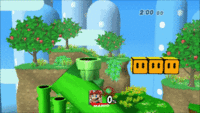
|
|---|
Taunts
- Up taunt: Turns into Super Mario; similar to Super Mario Bros. (Same as in SSB and Melee).
- Side taunt: Takes off his hat, twirls around with it out, and puts his hat back on; similar to his "level clear" animation from New Super Mario Bros..
- Down taunt: Spins in the air and falls on his back with his legs up; based on his dying animation from the original Donkey Kong.
| Up taunt | Side taunt | Down taunt |
|---|---|---|
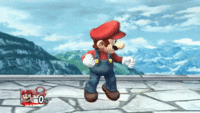
|
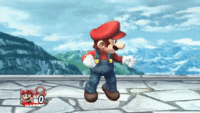
|
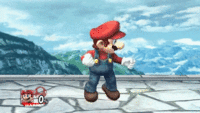
|
Idle poses
- Moves his head from left to right and holds his fists in front of his face.
- Adjusts his cap.
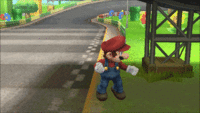 |
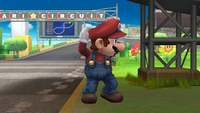
|
|---|
Crowd cheer
| English | Japanese | |
|---|---|---|
| Cheer | File:Mario Cheer NTSC Brawl.ogg | File:Mario Cheer JP Brawl.ogg |
| Description | Ma-Ri-O! | Ma-Ri-O! |
| Pitch | Group chant | Group chant |
Wii Remote selection sound
- Mario says "Here we go!".
Victory poses
- Up: Makes fire explode from his palm and strikes a pose.
- Left: Winds up for a punch and steps forward while punching in front of the screen. (Similar to his smash attack in Super Smash Bros.)
- Right: Does a short spin-jump and lands in a strong-man pose. (His "character chosen" animation in Super Smash Bros.)
| Up | Left | Right |
|---|---|---|
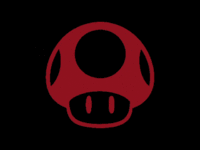
|
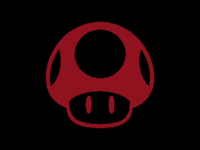
|
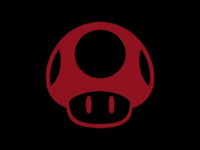
|
In competitive play
Matchups
Mario has a very poor matchup spread, especially beyond low tier. He counters one character, Ganondorf, soft counters three characters and has seven even matchups, but is soft countered by sixteen other characters, countered by five and hard countered by four. The lack of real strengths outside of his fast attacks puts him at a disadvantage against most of the cast, with his combo game possessing less use due to the introduction hitstun canceling, which combined with his struggle in landing his KO moves, limit his offensive game and approach. Characters like Marth or Meta Knight can easily edgeguard him and exploit his poor range. To make things worse, all of his matchups he does well against are all considered non-viable.
Most historically significant players
- See also: Category:Mario professionals (SSBB)
Boss - While better known for being considered the best Luigi in Brawl, he also frequently used Mario at high-level tournaments and was considered as possibly Mario's best player too. Placed 17th at Apex 2009 and MLG Columbus 2010 using Mario alongside Luigi.
Irios - The best Mario player in Europe and possibly the best Mario player in the world during Brawl's competitive life. Placed 5th at Bushido Impact 9 and has defeated Mr. R.
KirinBlaze - Dual mained Mario with Link, and was one of the very few well-renown Mario mains in Brawl. Placed 33rd at MLG Raleigh 2010 and Pound V. Has defeated players such as Will.
Tier placement and history
Since the very beginning of Brawl competitive play, Mario has always been viewed by serious players as a low-tier, nonviable character; as such, he never enjoyed a period of positive competitive prospects. Although Mario's attributes were not directly nerfed from Melee, professionals quickly noticed that his comparatively standard abilities mixed with the slower and floatier mechanics could not keep up with the newer and better competition. These traits kept Mario far from being viable even in the early stages of Brawl’s metagame; as such, despite his still rounded traits and low learning curve, his apex of potential for most players reached nowhere compared to that of many other characters ranked higher than him. As the metagame for other characters developed, Mario never had any competitive breakthroughs or significant advancements in general, steadily driving him further and further down the tier list.
Ever since Brawl’s metagame stagnating, Mario has been consistently stuck in 31st place. It is unlikely that Mario's competitive viability will ever improve in Brawl, due to his usage stemming from very few players ever maining Mario and even fewer playing him at a high level, resulting in extremely low representation in standard tournaments. In low tier tournaments, however, players can easily pick him up due to his low learning curve and play him to a reasonably competitive degree. Along with this, Mario performs reasonably well against other low tier characters, including a few positive matchups against those who are lower-tiered than him. While his standings against such ranked characters cannot make Mario fall any lower, he still fares poorly against a majority of the cast ranked above him, preventing him from rising any higher on the tier list and leaving him without a place in a high-level metagame.
Role in The Subspace Emissary
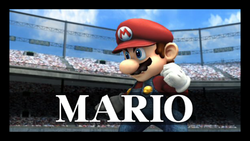
Mario is the main protagonist and the leader of the army of the heroes in The Subspace Emissary, and he is the first character to be formally introduced. In the beginning, trophies of Mario and Kirby are thrown into the Midair Stadium, where they come to life and have a friendly fight (a reference to the introduction in the first game of the series, where Mario and Kirby prepare to fight each other towards the end). The player chooses the one they want to play as, where the character not chosen is the opponent. After the battle between the two, the winner revives the loser, they shake hands, and wave to the crowd. Suddenly, ominous red clouds appear above the stadium, and the Halberd emerges from them. It releases Shadow Bugs which form into Primids. Peach and Zelda, who were watching the match, come to help, and after defeating all of the enemies, they are all confronted by the Ancient Minister. After seeing two R.O.B.s setting up a Subspace Bomb, Mario runs to try and stop it, only to be blasted out of the stadium and Star KO'd by a cannonball apparently fired by Petey Piranha. During his descent from Skyworld, Pit finds Mario's trophy and revives him. Once Mario recounts what happened, the two proceeded on their journey. When they reach the ground, they fight Primids across the Plain and attempt to stop the Ancient Minister from delivering another Subspace Bomb. Mario attempts to reach the Minister, but falls short; Pit also tries to get him by using a Footstool Jump on Mario, but he also fails. They then continue on their quest.
The Lake Shore
False Peach
At the shore, Kirby chases after a menacing noise he heard, unaccompanied by Peach. The abandoned princess is turned into a trophy by Bowser's Dark Cannon. A false character of Bowser appears and dissolves, engulfing Peach's trophy. Brought to life is a cloned Peach which tries to fire a Dark Cannon at Mario and Pit. Luckily, Link destroys the gun using his Master Sword, and fights the princess with Yoshi. Mario notices them standing by Peach's trophy, which disintegrates. Enraged, thinking that it is the real Peach, Mario attempts to attack Link, but he dodges the attack. Link, Yoshi, Mario, and Pit get into a two-on-two fight. Afterward, King Dedede's cargo, stolen from Wario and already loaded with the trophies of Zelda, Ness, and Luigi (the former of which is noticed by Link), grabs Mario and Pit's trophies with its mechanical arm. Fortunately, Kirby appears from behind and severs the arm with Final Cutter while reviving Mario and Pit; Kirby had realized that the noise he heard was Dedede hijacking the cargo from Wario. King Dedede turns around and tries to get away, but Pit blows the cargo's tire with Palutena's Arrow.
The five follow Dedede across some plains and follow him into the Cave, where they see Dedede's castle in ruins from an ambush by Bowser. They pursue Bowser through a hole in the castle wall. Mario and the others then confront Bowser at a cliff. Mario jumps at Bowser, but Bowser uses Zelda's trophy as a shield, forcing him to miss. Pit fires an arrow; Bowser, while sidestepping to dodge the arrow, drops the Dedede Brooch attached to Zelda's arm. He loses footing and falls off the cliff into the Koopa Clown Car with the trophy of Zelda, where he laughs maniacally as he flies up to the Halberd.
False Zelda
At the shore, Kirby chases after a menacing noise he heard, unaccompanied by Zelda. The abandoned princess is turned into a trophy by Bowser's Dark Cannon. A false character of Bowser appears and dissolves, engulfing Zelda's trophy. Brought to life is a cloned Zelda which tries to fire a Dark Cannon at Link and Yoshi. Luckily, Pit destroys the gun with his Palutena's Bow and fights the princess with Mario. Link notices them standing by Zelda's trophy, which disintegrates. Enraged, thinking it is the real Zelda, Link attempts to attack Mario, but he dodges the attack. Link, Yoshi, Mario, and Pit get into a two-on-two fight. Afterward, King Dedede's cargo, stolen from Wario and already loaded with the trophies of Peach, Ness, and Luigi (the former of which is noticed by Mario), grabs Link and Yoshi's trophies with its mechanical arm. Fortunately, Kirby appears from behind and severs the arm with Final Cutter while reviving Link and Yoshi. King Dedede turns around and tries to get away, but Link blows the cargo's tire with his Hero's Bow.
The five follow Dedede across some plains and follow him into the Cave, where they see Dedede's castle in ruins from an ambush by Bowser. They pursue Bowser through a hole in the castle wall. Mario and the others then confront Bowser at a cliff. Mario jumps at Bowser, but Bowser uses Peach's trophy as a shield, forcing him to miss. Pit fires an arrow; Bowser, while sidestepping to dodge the arrow, drops the Dedede Brooch attached to Peach's chest. He loses footing and falls off the cliff into the Koopa Clown Car with the trophy of Peach, where he laughs maniacally as he flies up to the Halberd.
Story merge
They later catch up to the Ancient Minister in a desert, and after failing to stop a Subspace Bomb from detonating, barely escape the blast. Mario then leads his team at the Canyon, saving Marth, Ike, Lucas, Pokémon Trainer and Ice Climbers from a horde of Primids. The ten of them camp out for a while, until Mario spots an enormous explosion of Subspace Bombs from the Isle of the Ancients. Shortly afterward the Halberd lands, which has been retaken by Meta Knight, Lucario, Snake, Peach, Zelda, Fox, Falco, and Mr. Game & Watch. Next to it is the Falcon Flyer, containing Samus, Pikachu, Olimar, Captain Falcon, Diddy Kong, Donkey Kong, and R.O.B..
Mario and company destroy the Subspace Gunship, enter Subspace itself and eventually reach Tabuu. Unfortunately, Tabuu turns all of the fighters into trophies using his Off Waves. Mario is later resurrected by King Dedede, Ness, and Luigi and helps the other heroes through the Great Maze. In Tabuu's Residence, Tabuu poises to unleash more Off Waves. However, Sonic appears and impedes this by damaging his wings. Mario joins the battle against Tabuu, eventually defeating him and ending the Subspace invasion.
Playable appearances
- Midair Stadium
- Skyworld
- The Plain
- The Lake Shore
- The Cave
- The Wilds (Part II)
- The Canyon
- Entrance to Subspace
- The Great Maze (if rescued in Subspace (Part I))
Using stickers
Since Mario's primary attacks are kicks, Leg stickers have the widest effect, with Arm attacks as a secondary. Using a Head sticker will usually only affect Mario's up smash (since pummels cannot be used against most enemies), while a Flame one will affect both his Fireball and his forward smash's sweetspot. The Mario Tornado is considered a Spin attack, but as it's Mario's only Spin attack, using a Spin sticker will not have a very large effect. This also applies with Weapon stickers and his Cape.
Exclusive stickers
The following stickers can either only be used by Mario, or can only be used by a select few, including Mario:
- 1-Up Mushroom: [Leg] Attack +4
- Bowser (Dance Dance Revolution: Mario Mix): [Throwing] Attack +20
- Bowser (Mario Kart 64): [Weapon] Attack +13
- Bowser (Super Paper Mario): [Arm] Attack +23
- Coin: [Specials: Indirect] Attack +4
- Dice Block: [Arm] Attack +8
- Dr. Mario: [Head] Attack +18
- Koopa: [Body, Spin] Attack +10
- Lakitu (Mario Kart: Super Circuit): [Leg] Attack +13
- Mario (Mario Kart DS): [Leg] Attack +22
- Mario & Yoshi: [Specials: Indirect] Attack +13
- Mega Rush Badge: [Specials: Direct] Attack +8
- Mushroom: [Arm, Leg] Attack +5
- Peach (Super Princess Peach): [Weapon] Attack +23
- Peach (Mario Superstar Baseball): [Slash] Attack +5
- Rawk Hawk: [Arm] Attack +5
- Red Fire: [Flame] Attack +26
- Super Mario Bros.: [Arm, Leg] Attack +15
- Toad & Toadette: [Head] Attack +16
- Waluigi (Super Mario Strikers): [Slash] Attack +15
- Waluigi (Mario Superstar Baseball): [Specials: Indirect] Attack +8
- Yoshi (Yoshi Touch & Go): [Arm, Leg] Attack +8
- Yoshi (Paper Mario: The Thousand Year Door): [Throwing] Attack +5
In Event Matches
Solo Events
- Event 1: Two Trouble Kings: Mario must defeat both Bowser and King Dedede on Delfino Plaza.
- Event 6: Super Bowser Bros.: The player controls Bowser, who must reach the flagpole in Mushroomy Kingdom without getting KO'd by three other Marios.
- Event 10: All-Star Battle Regulars: Mario is one of the opponents fought in this event. All opponents are starters from the original Super Smash Bros. game.
- Event 19: Wario Bros.: The player controls Wario and must defeat Mario and Luigi on the Mario Bros. stage.
- Event 41: The FINAL Final Battle: The player must defeat a giant Mario along with Snake and Sonic on Final Destination.
Co-op Events
- Co-Op Event 1: Two Trouble Kings: Mario and Kirby must defeat both Bowser and King Dedede on Delfino Plaza.
- Co-Op Event 8: All MINE!: Wario and Bowser must collect 2,000 coins together in Skyworld while fighting against Mario and Luigi.
- Co-Op Event 17: Sonic and Mario: Sonic and Mario must KO 3 other Sonics and 3 other Marios on the Green Hill Zone stage.
- Co-Op Event 21: The True All-Star Battle: Two players select a character and take on the entire roster on Battlefield.
Trophies
Mario's main and Final Smash trophies can be obtained by clearing Classic Mode and All-Star mode respectively with Mario.
- Mario
- A familiar overall-clad figure who is Nintendo's flagship character. His courage and jumping ability have seen him through countless adventures. He's a multitalented plumber with the knowledge of a physician, a top-notch golfer, and a veteran tennis umpire. Is his jumping prowess a boon from his girder-climbing days?
- Mario Finale
- Mario with a Smash Ball, unleashing his ultimate attack. The twin dragons of flame he releases wallop all characters in range. The flames spread up and down, so it's best to release them from the edge of the screen at an appropriate height. His flaming eyes are proof of his excitement for this explosive attack.
Alternate costumes

| |||||
Trivia
- Mario, when doing his up taunt while under the effect of a backfire Lightning Bolt that makes him larger while playing Giant Brawl, will become the largest size a player can achieve without hacking or glitches.
- Mario is tied with Kirby for being playable in more levels of the Subspace Emissary than other characters, being playable in 9 levels. Despite this, it is possible to never play as him at any time (as the player always has other characters available to use instead of Mario).
- He is also one of several characters who can be unlocked before the Great Maze but cannot fight any bosses in the story on the first playthrough.
- Despite having a very close relationship in the Mario series, Mario and Luigi never interact with each other in the Subspace Emissary.
- Mario, Bowser, Ganondorf and Link are the only returning characters in Brawl to have at least one completely different special move. In this case, Mario's down special move is changed. Additionally, Mario is the only character to have a special move from a previous game turned into a standard attack in Brawl.
- He is the only one of these four whose changed move was not a side special.
- Although Mario has the ability to crawl in some of his games, he cannot crawl in Super Smash Bros. Brawl, while Luigi can.
- This marks the final appearance of Mario's original blue shirt and red overalls alternate costume worn since the original Super Smash Bros. to date.
External links
- Mario's page at Smash Bros. Dojo!!
- Mario Character Guide on SmashBoards
- Mario's Moves - History Behind Super Smash Bros. Brawl, by CrappyCaptureDevice
| Fighters in Super Smash Bros. Brawl | |
|---|---|
| Veterans | Bowser · Captain Falcon · Donkey Kong · Falco · Fox · Ganondorf · Ice Climbers · Jigglypuff · Kirby · Link · Luigi · Mario · Marth · Mr. Game & Watch · Ness · Peach · Pikachu · Samus · Yoshi · Zelda / Sheik |
| Newcomers | Diddy Kong · Ike · King Dedede · Lucario · Lucas · Meta Knight · Olimar · Pit · Pokémon Trainer (Charizard · Ivysaur · Squirtle) · R.O.B. · Snake · Sonic · Toon Link · Wario · Wolf · (Zero Suit Samus) |


